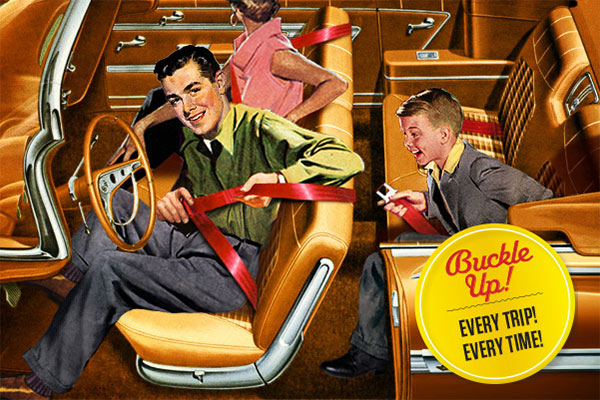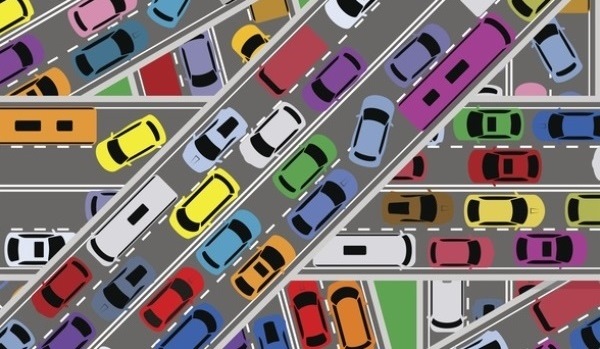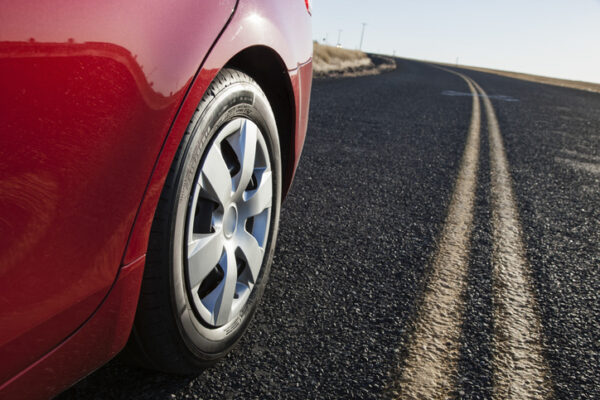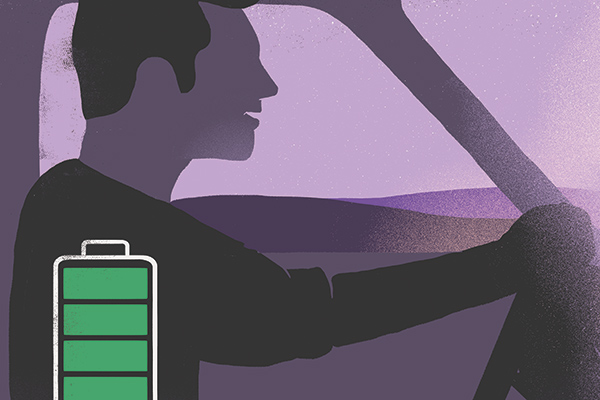Seat belts reduce serious crash-related injuries and deaths by about half, according to the National Highway Traffic Safety Administration. The simple act of wearing a seat belt is the single most effective way to reduce the risk of fatality in a crash. So why do millions of people not buckle up on every trip? Let’s debunk five common myths about wearing seat belts that are outdated or just plain wrong.
5 Common Misconceptions About Seatbelts
#1: Seat belts are uncomfortable and restrict my movement.
Wearing a seat belt should not cause any discomfort or pressure when adjusted properly. Seat belts have come a long way in the comfort department since becoming a mandatory feature in cars in the 1960s. Technological advancements like polyester webbing and pretensioners, which eliminate slack in the event of a crash, have made seat belts more comfortable for the wearer. If you want to customize your fit, you can find clips and extenders at your local dealer or auto parts store.
With children, the shoulder belt should fit across the shoulder and chest, and the vehicle lap belt should fit across the upper thighs. (Children are typically between the ages of 8 and 12 years old when they are ready for a seat belt. A good test is if their knees bend at the edge of the seat when backs and bottoms are pressed against the vehicle seat back.)
Pregnant women should wear both the lap belt and the shoulder strap, ensuring a snug fit. Lap belts should be buckled under the belly and over hips. Never place the lap belt across your belly. The shoulder strap should go between the breasts and off to the side of the belly. Never place the shoulder strap under the arm.
#2: Seat belts trap you in your vehicle during a crash.
This myth is often associated with fire- and water-related accidents, which account for less than one-half of one percent of all crashes. More importantly, seat belts can actually prevent you from being knocked unconscious, which can increase your chances of escaping during an accident.
#3: I’m just going up the block for groceries. I don’t need to wear a seat belt around town.
Think again. Routine, seemingly low-key trips can be deceptively dangerous. Did you know that most traffic-related deaths happen within 25 miles from your house and at speeds less than 40 mph, according to the National Highway Traffic Safety Administration? Don’t take any chances. Your life and the lives of your passengers are at stake.
#4: I don’t have time to put on my seat belt.
It only takes about three seconds to strap on your seat belt. That’s less time than it takes to tie your shoe. Even if you’re buckling up 20 times a day, that’s only one minute of your day.
#5: My car has air bags, so I don’t need to wear a seat belt.
Air bags are designed to protect a buckled passenger, not an unbuckled one. Seat belts secure you in the proper position to benefit from an air bag deployment. If you’re not wearing your seat belt, you’re in danger of sliding underneath the air bag, colliding with the dashboard or windshield, or being ejected from the front seat. Air bags are a supplemental form of protection and most are designed to deploy in moderate-to-severe frontal crashes, which doesn’t cover all situations. Using air bags in conjunction with seat belts is your best bet.
The History Of Seatbelts
 Forget statistics, campaigns or pleas from car manufacturers. As the history of the seatbelt shows, the most effective way to get drivers and passengers to buckle up is to hit them where it hurts: in their wallets.
Forget statistics, campaigns or pleas from car manufacturers. As the history of the seatbelt shows, the most effective way to get drivers and passengers to buckle up is to hit them where it hurts: in their wallets.
Although lap belts were offered in cars as early as the 1950s, they were snubbed by many until 1984, when New York became the first state to crack down on car safety. “The thing that started to get people to buckle up in large numbers was simply having state laws with a minimal fine of $25 or $50 for not buckling up,” says Mike Ciccone, senior director of crashworthiness evaluations at Insurance Institute for Highway Safety (IIHS).
The importance of using seatbelts is no joke. No other quick daily habit—not even eating your veggies—has such life-changing benefits. “Lap and shoulder belts are about
50 percent effective in preventing fatal injuries to front‐seat occupants in crashes of all kinds,” says Ciccone. The numbers are staggering: Safety belts saved 12,802 lives in 2014, according to the National Highway Traffic Safety Administration (NHTSA). Compare that with the early 1980s, when just roughly 11 percent of front-seat passengers wore belts. So when did people buckle down on buckling up? Here, a look back at the invention, technology and laws behind seatbelts.
1885: The U.S. Patent Office issues the first seatbelt patent.
1949-50: Nash Motors Company offers lap belts in certain car models.
1959: Volvo engineer Nils Bohlin invents the first three-point safety belt in Sweden by combining the lap belt and shoulder strap into one continuous belt that could be buckled with one hand. The invention’s open patent allows other manufacturers to adopt the game-changing design.
1968: The first federal law regarding seatbelts—called the Federal Motor Vehicle Safety Standards—is passed, requiring all new cars sold in the U.S. to feature lap or shoulder belts in the front seats and lap belts in the back seats.
1984: New York passes the first “primary enforcement law,” in which a police officer can pull over and ticket a driver just for not wearing a seatbelt. Thirty-four states now have primary enforcement laws, while 15 states have secondary laws, which means drivers pulled over for another reason can receive a ticket for not wearing a seatbelt. The fear of getting ticketed led to a quick jump in seatbelt usage for those states, which meant fewer deaths and injuries. People pay more attention to primary laws, and buckle up more. According to IIHS, if all states with secondary laws had primary laws instead, their passenger deaths would decrease by 7 percent.
1993: North Carolina’s “Click It or Ticket” campaign, which involved TV ads and billboards highlighting the cost of getting pulled over, dramatically increases seatbelt use from
65 percent to 81 percent. A decade later, the “Click It or Ticket” campaign goes national.
2015: States with primary enforcement laws report seatbelt usage at 91 percent, and states with secondary enforcement laws (or no law at all) report seatbelt usage at 79 percent.
Living in such a rapidly changing world, it’s easy to take innovations for granted, but remember that seatbelts were designed with one goal in mind: to protect you. Don’t forget to buckle up on your next ride—and that goes for everyone, especially kids and even pets.
You always buckle up … right? Good. GEICO offers discounts to good drivers. See how much you could save.
Next article: 5 Common Driving Myths Debunked
By Stephanie Levis and Kara Cutruzzula









Barbara Harris says,
You should wear a seat belt because they can keep up safe,and protect u.you have to be careful and very safe ,when it come with the safety of our lives and children. .
Patrick deLaureal says,
I personally think that if you are going to ride with someone else…..the operator should be directly responsibility for securing the bodies with the restraints……………..yes if you drive the car YOU should belt the passengers…..hands on.
Clark Pickens says,
I was in an accident where the belted passenger was crushed in his seat while I was thrown clear. I will never wear a “Death Strap” in my life.
They also create back pains, heartburn and claustrophobia.
Seat belts should be a choice because it harms no one else.
Patrick deLaureal says,
….sorry, but you do harm me…….regardless of your view of your personal experience…..the suggestion that active restraint conditioned that fatality…is no more than wishful thinking.
And results of safety on the road, is reflected in my rates.
Patrick deLaureal says,
….cam you comment as to how pleasant ….being “thrown clear”……..was”?
Patrick deLaureal says,
No…..active restraint in a motor vehicle is not………..five part harness is……but most places no it’s not a choice.
Mark says,
I survived beltless from a rollover in 2004. I flipped my SUV onto the driver’s side after I was hit by an out-of-control car that had just hit a deer.
If I had the belt on, I may not of survived or had permanent brain injury(s).
Robert Haight says,
With seal belt mandates now in most states; why are there also airbags? I thought airbags came in use due to many not wearing seatbelts. I don’t like flying shrapnel in my face. Again, what is the reason for this redundancy?
Patrick deLaureal says,
“Active restraints” are far and away more likely to effect outcomes…….passive restraints can save you..but active restraints will…if you will survive at all.
Craig M. Bryda says,
I live in New York, when I drive my ’40 Ford that does not have seat belts, will I be ticketed for not complying to the seat belt law ?
Patrick deLaureal says,
In NY state….I’m not sure….but the incentive is plain….outside of the law enforcement…?
Patrick deLaureal says,
In this election year, something I think I see often is candidates getting in and out of vehicles, but it’s hard to tell if they are using active restraints……maybe they are.
I’ll ask: When in a limousine or a cab or a Uber, or someone else’s car….do you secure yourself?
If you don’t, you are relying on another’s underwriter, who you don’t know, have never paid, to take care of whatever happens.
Patrick deLaureal says,
If the usage numbers are high …proper usage remain not at all as good.
Forget about so many fingers or some other way of adjusting your belt , and try to consider this , get used to adjusting the lap part EVERY TIME you get behind the wheel , so that it feels that it is actively keeping you in that seat, you should know it is there. Next with the shoulder part in place extend it away from your body allow it to retract and position itself , on its own.
This 4 second test let’s you know your equipment will work as intended. Every time.
Dan says,
But,do they save lives and can you prove it. Everything else is just talk.
Mike Davis says,
I always wear my seat and won t move the car until everyone is belted.
Leonardo Fernandez says,
Seatbelt save life.
Chris says,
That was a worthless read. The public doesn’t need a history lesson . They need to read how they save lives . They need to read that a rear passenger will literally crush a front passenger in a front collision . They need to read that when you roll your truck, your a ping pong ball in the cab. They need to know that when you wear a seatbelt, and you find yourself off the road, or making drastic evasive maneuvers, you may just get out of it since the belt keeps you in your seat and possibly a ble to control your vehicle.
Jonathan says,
The key remark for the article “lap and shoulder belts are about 50% effective”
The reality is .000000001 effective which cost insurance companies untold amounts of revenue each year. The law was passed because of this lost revenue, not for our safety.
Fortunately, I’m able to write this remark because I was NOT wearing one the day a teenager ran a red light. The accident totaled my first brand new car (note: she had no insurance) and I would have been killed had I been strapped into my seat.
A fifty dollar fine because our right to decide was removed for insurance companies best interest is better than being six feet under.
Anthony Cora says,
Very useful information, unknown to many driver worldwide.thanks for the input!!
Samuel Fernandez-Montero says,
What buckle up means for me ??
Everything …….
Cause I work overnights and I have 3 handsome sons that wait for me every morning at home….. So that’s the first thing I do before I’ll drive 🙂
Caitlyn Jenner says,
Buckle up, buckaroos!